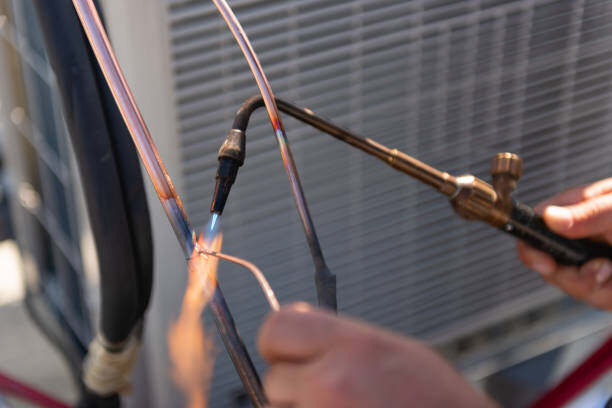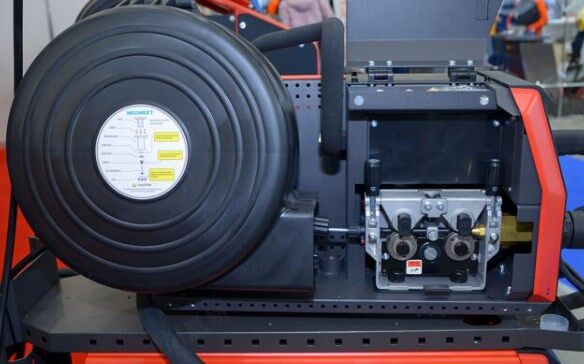Aluminum's lightweight strength and superior corrosion resistance have propelled it to the forefront of industrial materials, finding its way into everything from automobiles to consumer electronics. This surge in aluminum's popularity has correspondingly increased the demand for skilled aluminum welders. While experienced steel welders might initially find aluminum welding challenging, mastering the nuances of this process opens up a world of fabrication possibilities. This comprehensive guide delves into the intricacies of aluminum MIG welding, focusing on equipment selection, setup optimization, and the selection of appropriate wire feeding systems to ensure smooth, high-quality welds.

I. Understanding the Unique Demands of Aluminum MIG Welding
Aluminum's inherent softness and distinct metallurgical properties necessitate a departure from standard steel welding techniques and equipment. A direct application of steel welding parameters to aluminum will almost certainly result in subpar welds, marred by excessive spatter, poor penetration, and even damage to the welding equipment itself. Understanding and addressing these differences is critical for successful aluminum MIG welding. This involves careful consideration of three key areas:
Optimized Equipment Setup: From liners and wire guides to drive rolls and contact tips, every component needs to be carefully chosen to minimize friction and prevent damage to the soft aluminum wire. Improper setup can lead to wire breakage, inconsistent welding, and increased wear on your equipment.
Appropriate Power Source Selection: The power source plays a crucial role in delivering consistent arc characteristics and controlling the heat input during the welding process. The choice of power source depends significantly on welding frequency and the thickness of the materials being joined.
Strategic Wire Feeding System Selection: The method of feeding aluminum wire significantly impacts the quality and consistency of the weld. Different feeding systems—push, spool gun, and push-pull—offer distinct advantages and disadvantages depending on the specific application. Choosing the right system is paramount for optimal performance and avoiding common problems like wire tangling (birdnesting).
II. Optimizing Your Aluminum MIG Welding Setup
The success of aluminum MIG welding hinges on meticulous attention to detail in equipment setup. Here's a detailed breakdown of the crucial adjustments required:

1) Liner Material:
Steel liners, common in steel welding, are unsuitable for aluminum due to their abrasive nature. Replace them with nylon or Teflon® liners, which minimize friction and prevent wire scratching, leading to smoother wire feeding and reducing the risk of wire breakage.
2) Wire Guides:
Similar to liners, wire guides should be made of nylon or Teflon® to ensure smooth, frictionless wire movement and prevent the formation of wire shavings. Steel wire guides can cause significant damage to the soft aluminum wire.
3) Drive Roll Grooves:
The drive rolls are responsible for gripping and feeding the wire. Steel welding typically uses V-shaped grooves, but aluminum welding necessitates U-shaped grooves to eliminate sharp edges that can damage the wire. Furthermore, reduce the drive roll tension compared to steel welding settings to avoid crushing the soft aluminum wire.
4) Contact Tips:
Aluminum's higher thermal expansion coefficient compared to steel requires the use of larger contact tip orifices. Improperly sized contact tips result in poor electrical contact, leading to noticeable issues like wire shavings, excessive arcing, and inconsistent wire feeding. Always use contact tips specifically designed for aluminum.
5) Brake Tension:
Loosen the brake tension on the wire spool compared to steel welding settings. Excessive tension makes it difficult for the wire to feed smoothly, potentially leading to inconsistent welding.
6) Gun Cable Management:
Aluminum's lower tensile strength requires careful attention to gun cable management. Keep the gun cable as straight as possible to minimize bending and prevent wire tangling. Avoid sharp bends or kinks that can obstruct wire flow.
7) Gas Flow and Shielding:
Employing an inert gas like argon or a mixture of argon and helium is crucial. These gases prevent oxidation and provide a stable arc, resulting in cleaner, more consistent welds. Maintain proper gas flow rates as specified by the manufacturer. Even small leaks can compromise the weld quality and lead to porosity.
III. Selecting the Right Power Source
The choice of power source directly influences the welding process's efficiency and quality. This selection should account for welding frequency and the typical thicknesses of the aluminum components being joined.
1) Infrequent Aluminum Welding:
For occasional aluminum welding tasks, a smaller, 130-170 amp wire feed welder system often suffices. However, these systems typically have limitations in terms of weldable material thickness (usually 3/32" to 3/16"). Ensure that you purchase a manufacturer's aluminum welding kit to obtain the right liners and tips.
2) Frequent Aluminum Welding:
For more demanding applications involving thicker materials or higher welding frequencies, a larger capacity power source (200-300 amps or more) is necessary. These systems offer greater versatility and handle thicker aluminum more effectively. Features such as pulse welding capabilities and adjustable settings for voltage, wire feed speed, and inductance are highly beneficial. Pulse welding is especially useful for thinner aluminum sheets, reducing heat input and minimizing the risk of burn-through.
3) Specialized Features:
Consider features like hot start, which boosts the current initially to initiate the arc more easily, and arc force, which helps to maintain a stable arc while welding. These features are particularly helpful when welding aluminum, which tends to stick to the contact tip. Additionally, look for power sources that provide precise control over wire feed speed and voltage.
IV. Choosing the Optimal Wire Feeding System
The wire feeding system is crucial to the success of aluminum MIG welding. Three main types of systems are commonly used: push, spool gun, and push-pull. Each has its own set of advantages and limitations:
A. Push System:
Description: This simple system uses a single motor in the wire feeder to push the wire through the gun. It's the least expensive option, but it's generally less suitable for aluminum due to the wire's softness and tendency to tangle. It's best suited for shorter welds and thinner aluminum materials.
Advantages: Simple, inexpensive, compact.
Disadvantages: Prone to wire tangling, limited reach, not ideal for longer welds or thicker materials.
B. Spool Gun System:
Description: This system employs a dedicated spool gun with a motor built into it. The motor is located near the workpiece, reducing the wire's length and minimizing the risk of tangling. It enhances reach but requires frequent wire spool changes due to the small spool capacity.
Advantages: Improved reach (up to 50 ft.), reduces wire tangling compared to push systems.
Disadvantages: Limited spool capacity (typically 1 lb.), frequent spool changes, and higher cost than push systems. Can be cumbersome for welding in tight spaces due to its larger size compared to push systems.
C. Push-Pull System:
Description: This system uses two motors: one in the wire feeder (push motor) and another in the gun (pull motor). The push motor helps feed the wire, while the pull motor actively pulls the wire through the gun. This balances the forces acting on the wire, leading to the smoothest wire feeding and preventing tangling even with longer wire lengths.
Advantages: The most versatile and reliable system for aluminum. Can accommodate any aluminum wire type and size, including soft 4043. It handles larger wire spools (up to 20 lbs.), minimizing spool changes and reducing cost per pound of wire. Excellent wire feeding consistency for both short and long welds. Suitable for all thicknesses.
Disadvantages: More complex and expensive than push and spool gun systems, needing more components.
V. Conclusion
Successful aluminum MIG welding necessitates a profound understanding of the material's properties and meticulous attention to detail in equipment setup. By carefully selecting the appropriate power source, and wire feeding system, and by employing proper techniques, welders can achieve high-quality, consistent welds and make the most of aluminum's versatile properties. Remember that practice is key; continuous refinement of your techniques will lead to improved weld quality and increased efficiency.
Related articles:
1. How to Successfully MIG Weld Aluminum [Guide]?
2. Advantages of Utilizing Pulsed MIG Welding for Aluminum
3. Pulsed MIG Welding Aluminum and Stainless Steel
4. MIG and TIG Guidelines for Aluminum Welding
5. MIG Welding Aluminum Essential Tips and Techniques





